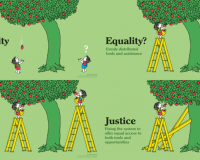
Vibrant Environment
Environmental Justice
All | Biodiversity | Climate Change and Sustainability | Environmental Justice | Governance and Rule of Law | Land Use and Natural Resources | Oceans and Coasts | Pollution Control

Climate change poses unique dangers and challenges for people with disabilities. Unfortunately, despite wide recognition of the vulnerabilities of people with disabilities to climate change, disability perspectives and needs remain largely excluded from climate adaptation and mitigation efforts. Effective and inclusive climate action planning is essential to protecting the 26% of Americans who experience a disability from the most dangerous aspects of climate change.

This is Part 2 of a two-part blog series on climate change and its impact on indigenous peoples in the United States. Part 1 introduced the impacts of climate change on indigenous communities, while Part 2 provides specific examples of how these communities are responding in order to protect their land, people, and resources.

This is Part 1 of a two-part blog series on climate change and indigenous peoples in the United States. Part 1 introduces the impacts of climate change on indigenous communities, and Part 2 looks more in depth at how these communities are responding in order to protect their land, people, and resources.

On May 26, Engine No. 1, an activist hedge fund owning 0.02% of ExxonMobil’s stock, led a shareholder revolt against the oil giant, ousting three of Exxon’s board members despite opposition from senior management. The change was part of a recent tide of losses for the global oil industry. Chevron’s shareholders also displayed an intolerance for corporate negligence toward climate change when they passed a resolution mandating the company to account for and cut down on Scope 3 emissions, which are released in the process of oil combustion. These emissions make up a far larger share of the company’s carbon footprint than emissions from operations and extraction. Together, these shareholders are jointly calling on the oil industry to adapt its business model to align with a decarbonized economy.

Already under ever-increasing threats from climate change, the world faced another crisis in 2020: the COVID-19 pandemic. A public health emergency of this scale requires swift and effective policy action—but in many cases, the United States fell short, revealing ongoing failures to address systemic injustices exacerbated by the disease. In this month’s issue of ELR—The Environmental Law Reporter, members of the Environmental Law Collaborative, an affiliation of environmental law professors, examine the country’s legal responses to COVID-19, offering thoughts about pandemic ripple effects and their implications for environmental policy, as well as potential opportunities going forward. The article is excerpted from their book, Environmental Law, Disrupted, to be published by ELI Press later this year.

As summer approaches, school systems throughout the United States are planning for in-person and hybrid learning next fall. Since the beginning of the pandemic, Congress has appropriated $190 billion to assist those efforts; the recent American Rescue Plan Act alone provides around $122 billion for PK-12 public education.

I was introduced to mangroves early in my childhood during family trips to Bear Cut in Key Biscayne, Florida—the same plants that grew in my family’s hometown on the northern coast of Cuba. In 2003, I first used mangrove imagery in my artwork as a metaphor for the immigrant. I imagined the mangrove propagules floating along the water and setting root on a sandbar. Little by little they would grow alongside each other, capture sediment, create land, and build new habitats. Like immigrants in a community who come together to support one another, the roots of each mangrove tree come together to create a formidable structure that protects against the dangers of storm surge.

Climate change and environmental degradation not only pose visible threats to the well-being of millions today, but also present hazards to future generations—challenging the principle of intergenerational equity. Intergenerational equity, a concept that calls for fairness and justice between generations, requires that past, present, and future generations share the Earth’s resources in a fair and equitable manner. Related to this is the concept of intergenerational well-being, which calls on present generations to live and govern in a way that will allow future generations to live healthy and complete lives.

President Joseph Biden’s March 30 announcement to spend $2 trillion fighting climate change, decarbonizing the economy, and creating jobs did not lack detail—the White House “summary” ran 25 pages with 79 subheadings, each containing numerous subproposals. Among these big ideas about offshore wind development, digital grid infrastructure, and green job training programs is a proposal that could have come from any administration over the last five decades: redeveloping blighted industrial properties to improve outcomes for distressed, disadvantaged communities.

Environmental justice (EJ) in federal policy to date has mostly involved conducting more public participation—a “process without substance,” as EJ pioneer Charles Lee puts it. In this month’s issue of ELR—The Environmental Law Reporter, Lee offers a road map for government agencies to effectively address EJ issues by developing an understanding of disproportionate impacts based on rigorous, holistic data, and operationalizing this analysis with a spectrum of policy actions.